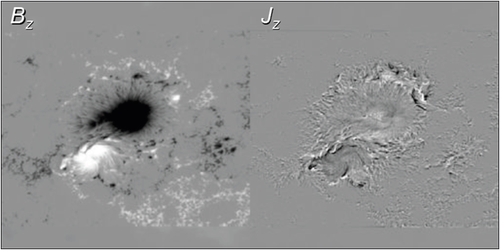Organisation and dynamics of surface magnetic field
Magneto-convective processes in the photospheric and sub-photospheric layers of the Sun play crucial roles in the magnetic structuring and dynamics of upper atmospheric layers. The near-surface layers are the regions where the plasma β (= the ratio of gas to magnetic pressure) transitions from β>>1 in the interior to β<<1 in the outer atmospheric layers. The β~1 photospheric boundary layer is also the region where the continuum optical depth τc~1, which separates the optically thick interior from the thin outer atmosphere. Hence, this boundary layer is subject to a strong coupling of very different scales of dynamical interests, and is difficult to study both observationally and theoretically.
Both very fast imaging and fast spectroscopic measurements are necessary to study the highly complex processes in this region. Spectropolarimetry, the study of Stokes vectors (Polarization) of a spectral line to infer physical conditions prevailing in a dynamic magnetized medium is the most sensitive tool that is available.
Flux emergence and active region dynamics

Emerging magnetic flux through the β~1 layers expand and merge above a certain height called the "magnetic canopy height" and fill the available space in the β<<1 region. Below the photosphere, due to the dominant gas pressure forces, the magnetic fluxes are passive and are confined to individual and separated flux tubes. The emergence from below is, thus, in the form of individual flux tubes, which are expected to carryoppositely directed currents on either side of the flux tube boundaries as well as twists.
Measurements of currents and twists in emerging flux tubes is important both to infer the dynamical evolution of the magnetic flux tubes while they rise through the solar interior to the surface as well as to understand the role of the twist leading to instabilities and eventual dissipation of magnetic energy in the solar atmosphere. Studies of helicity and energy fluxes in active regions (e.g. Ravindra et al., 2008) give important insights into the coronal dynamics and activity.